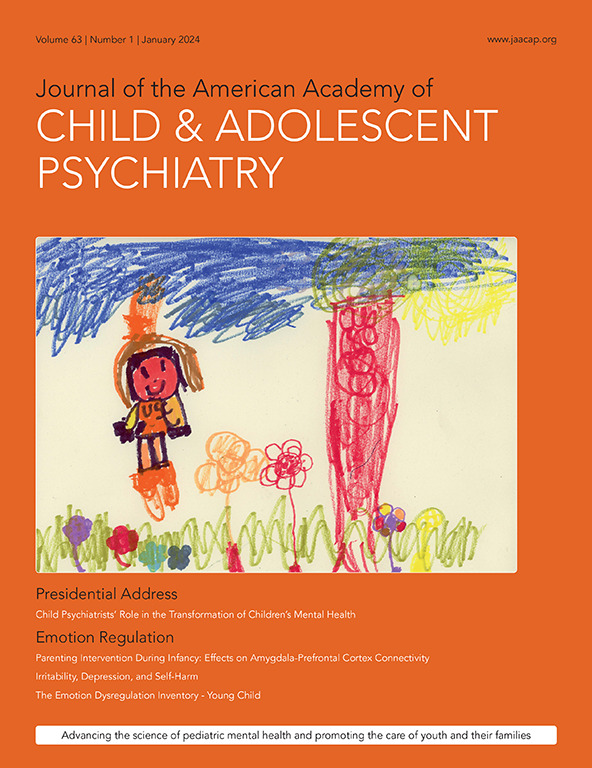Prenatal Antidepressant Exposure and Risk of Depression and Anxiety Disorders: An Electronic Health Records-Based Cohort Study.
IF 9.2
1区 医学
Q1 PEDIATRICS
Journal of the American Academy of Child and Adolescent Psychiatry
Pub Date : 2025-04-04
DOI:10.1016/j.jaac.2025.03.026
引用次数: 0
Abstract
OBJECTIVE To examine the associations of serotonergic antidepressant exposure during pregnancy with the risk of depression and anxiety disorders in offspring. METHOD The Mayo Clinic Rochester Epidemiology Project medical records-linkage system was used to study offspring born to mothers who were prescribed selective serotonin reuptake inhibitors or serotonin-norepinephrine reuptake inhibitors (S/NRI users, n=837) during pregnancy (1997-2010). Cox regression models were used to calculate hazard ratios (HRs) to examine associations of S/NRIs with diagnosed depression and anxiety, defined based on a review of medical records by two board-certified psychiatrists, using no maternal antidepressant use during pregnancy (non-users, n=863) and maternal antidepressant use in the year prior to pregnancy (former users, n=399) as control groups. RESULTS After all adjustments for covariates, children born to S/NRI users during pregnancy did not differ in onset of depression or anxiety than the children of non-users (Adjusted Hazard Ratios, (aHR [95% CI]=1.00 [0.74, 1.85]) or former users (aHR=0.94 [0.69, 1.27]). The above associations were similar when exposure was limited only to SSRIs. CONCLUSION Our results suggest that the higher rates of childhood and adolescent depression or anxiety conditioned on maternal S/NRI use in pregnancy are more likely to be driven by maternal depression or underlying propensity for depression rather than direct pharmacological effects of in utero S/NRI exposure.产前抗抑郁药物暴露与抑郁和焦虑症风险:一项基于电子健康记录的队列研究
目的探讨妊娠期5 -羟色胺类抗抑郁药暴露与后代抑郁和焦虑障碍风险的关系。方法采用梅奥诊所罗切斯特流行病学项目病历链接系统,对1997-2010年期间服用选择性血清素再摄取抑制剂或血清素-去甲肾上腺素再摄取抑制剂的母亲(S/NRI服药者,n=837)所生的后代进行研究。使用Cox回归模型计算风险比(hr)来检查S/NRIs与诊断出的抑郁和焦虑之间的关联,这些关联是基于两位委员会认证的精神科医生对医疗记录的回顾而定义的,使用孕期未使用抗抑郁药(非使用,n=863)和孕期前一年使用抗抑郁药(前使用,n=399)作为对照组。结果在所有协变量调整后,S/NRI使用者在怀孕期间所生的孩子与非使用者所生的孩子在抑郁或焦虑的发病方面没有差异(调整风险比(aHR [95% CI]=1.00[0.74, 1.85])或以前的使用者(aHR=0.94[0.69, 1.27])。当仅暴露于ssri类药物时,上述关联相似。结论:母亲妊娠期使用S/NRI导致的儿童和青少年抑郁或焦虑发生率较高,更可能是由母亲抑郁或潜在抑郁倾向驱动的,而不是子宫内S/NRI暴露的直接药理作用。
本文章由计算机程序翻译,如有差异,请以英文原文为准。
求助全文
约1分钟内获得全文
求助全文
来源期刊
CiteScore
21.00
自引率
1.50%
发文量
1383
审稿时长
53 days
期刊介绍:
The Journal of the American Academy of Child & Adolescent Psychiatry (JAACAP) is dedicated to advancing the field of child and adolescent psychiatry through the publication of original research and papers of theoretical, scientific, and clinical significance. Our primary focus is on the mental health of children, adolescents, and families.
We welcome unpublished manuscripts that explore various perspectives, ranging from genetic, epidemiological, neurobiological, and psychopathological research, to cognitive, behavioral, psychodynamic, and other psychotherapeutic investigations. We also encourage submissions that delve into parent-child, interpersonal, and family research, as well as clinical and empirical studies conducted in inpatient, outpatient, consultation-liaison, and school-based settings.
In addition to publishing research, we aim to promote the well-being of children and families by featuring scholarly papers on topics such as health policy, legislation, advocacy, culture, society, and service provision in relation to mental health.
At JAACAP, we strive to foster collaboration and dialogue among researchers, clinicians, and policy-makers in order to enhance our understanding and approach to child and adolescent mental health.

 求助内容:
求助内容: 应助结果提醒方式:
应助结果提醒方式:


